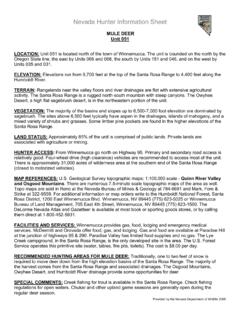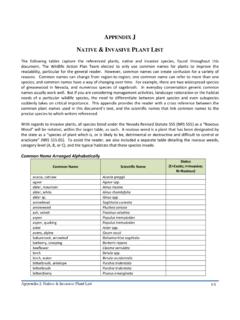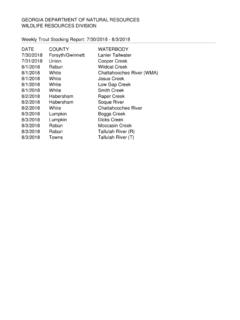Transcription of Venomous Reptiles of Nevada
1 Figure 1 Figure 2 Venomous Reptiles of Nevada Authors M. L. Robinson, Area Specialist, Water/Environmental Horticulture, University of Nevada Cooperative Extension Polly M. Conrad, wildlife Diversity Biologist Reptiles , Nevada department of wildlife Maria M. Ryan, Area Specialist, Natural Resources, University of Nevada Cooperative Extension Updated from G. Mitchell, Robinson, Hardenbrook and Sellars. 1998. What s the Buzz About Nevada s Venomous Reptiles ? University of Nevada Cooperative Extension Nevada department of wildlife Partnership Publication.
2 FS-98-35. The buzz from a rattlesnake can signal a heart stopping adventure to even the most experienced outdoor enthusiast. SP 07-07 (Replaces FS-98-35) Nevada S Reptiles Approximately 52 species of snakes and lizards share the Nevada landscape with us. Of these, only 12 are considered Venomous . Only 6 can be dangerous to people and pets. Encountering them is uncommon because of their body camouflage and secretive nature, which are their first defenses in evading predators. Consider yourself fortunate if you do see one!
3 As with all wildlife , treat Venomous Reptiles with respect. Reptiles are ectothermic, meaning their body temperature increases or decreases in response to the surrounding environment. They are most active in the spring, summer and early fall when it s comfortable, short sleeve weather for us. Reptiles usually hibernate, or brumate, in winter in response to colder temperatures. During high summer temperatures in the Mojave Desert, Reptiles may spend time underground in order to maintain vital body temperatures. In most cases*, collecting Nevada s native Reptiles is not allowed without the appropriate permit, which is issued by the Nevada department of wildlife .
4 Please visit to become familiar with the different types of collection, species allowed, limits and types of permits required by the department . THE Venomous SNAKES Nevada is home to five snake species that can be dangerous to people and pets. They are all members of the Viperidae family, the pit vipers. They are the sidewinder, Mohave, speckled, western diamondback and Great Basin rattlesnakes. With the exception of juveniles, most rattlesnakes we encounter in Nevada are 1 to 4 feet long. It is very important to remember that rattlesnakes do not always rattle their tails in warning and a rattle does not always precede a strike!
5 General Characteristics All rattlesnakes in Nevada have facial or loreal pits, heat-sensitive depressions, on either side of the head between the nostril and eye. These pits can detect differences in temperatures of less than F in nearby objects and aid rattlesnakes in detecting prey even in complete darkness. Compared to most non- Venomous snakes, rattlesnakes have broad, triangular shaped heads that accommodate the venom glands and muscles controlling them (see Figure 3). Pit vipers use fangs to dispense venom, which is a complex toxic compound used both to subdue prey and protect against predators.
6 Having the ability to dispense venom using these fangs can mean life or death for rattlesnakes. Page 2 When not in use, fangs are folded against the roof of the mouth (Figure 4). These fangs swing down as the snake lunges forward to strike and venom is dispensed through the fang into the prey. Fangs are not permanent and they are periodically replaced. The flexible jaws allow snakes to swallow their prey whole. Rattlesnakes have a triangular head that gives way to a narrow neck, thick body, and a tail tipped with a series of inter-locking segments making up the rattle.
7 Every time a snake sheds its skin a new segment is added. Snakes shed from one to three times a year and sometimes rattle segments break off, which is why rattlesnakes cannot be aged by simply counting the rattle segments (Figure 5). Rattlesnakes do not hatch from eggs; they are born alive from mid-summer to fall. The ability to vibrate the tail is instinctive, but the rattle cannot be heard until juveniles shed at least three times. Remember, juvenile rattlesnakes should not be mistaken as harmless, as they can deliver a fully potent bite and lack the ability to control the amount of venom injected.
8 Thin Body Thick Body Narrow Head Broad Head NON- Venomous Venomous Figure 3 Illustration courtesy of Robert C. Stebbins from his 1954 Amphibians and Reptiles of Western North America Figures 4 and 5 from: Pointed Tail No Rattle Rattle Page 3 Figure 4 Figure 5 Figure 6 Mohave Rattlesnake (Crotalus scutulatus) Also called the Mohave green, this snake (2 to 4 feet in length) mainly inhabits valleys and alluvial fans of southern Nevada (Figure 9). Notice the light to medium green body with yellow bordering darker diamonds on the back.
9 A pronounced dark stripe edged with yellow to yellow-green runs along both sides of the head angling down through the eyes to behind the corner of the mouth. The tail has contrasting narrow black and broad white bands, (Figures 10 and 11) (compare with Western Diamondback). The venom is very potent. Sidewinder (Crotalus cerastes) Named for its side-winding locomotion, it is Nevada s smallest rattlesnake, reaching up to 31 inches in length. Primarily inhabiting valleys and alluvial fans (Figure 6), a series of backward J or S shapes left in loose soil indicates one has passed by (Figure 2).
10 It will partially or nearly completely bury itself in loose sand or gravel when at rest (Figure 8). It is sometimes referred to as the horned rattler because of the modified scales above its eyes (Figure 7). Figure 8 Figure 9 Figure 11 Page 4 Figure 7 Figure 10 Distribution in Nevada . Distribution in Nevada . Speckled Rattlesnake (Crotalus mitchellii) Inhabiting rocky slopes and hills (Figure 12), this rattlesnake (2 to 4 feet in length) has the most variable body color and pattern of Nevada s rattlesnakes. Two sub-species occur in Nevada , the southwestern speckled ( pyrrhus) (Figure 13) and the Panamint ( stephensi, Figure 14).













